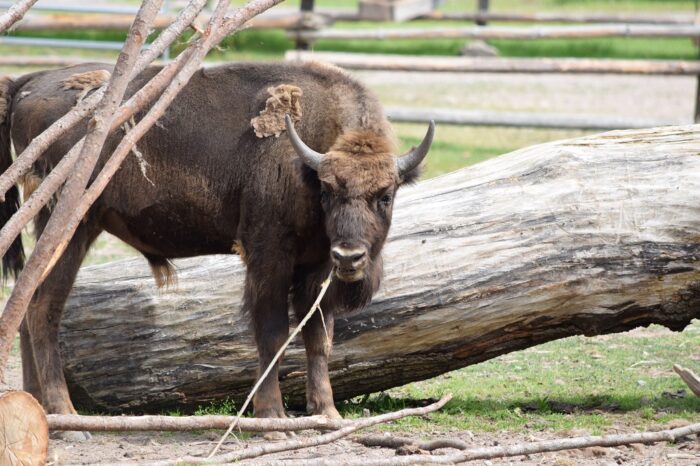A day trip somewhere from time to time is for us a way to keep our wanderlust at bay. From Stockholm, there are several places within a reasonable drive to visit, even though it always takes some time to get out from Stockholm itself. An hour and forty minutes away you find the small town of Avesta. As Little A likes animals our destination for the day was the Avesta Vicentpark or Avesta Bison Park in English. One of a handful of places in Sweden where it is possible to see the European Bison, also known as Wisent.
European Bison
It is sometimes hard to believe that the European continent once had large herds of bison roaming the landscape. Rewilding Europe, an organization working with the reintroduction of the Bison as well as other species provides a bit of history for the animal. The last wild animals in Europe were killed during the first world war. The last known animal died in Poland in 1919. The Russian Caucasus had wild bisons alive as late as 1927. A rescue operation started in 1923. At the time there were only 54 surviving bison in captivity at different zoos. The first European Bisons were introduced in the wild in Białowieża forest in Poland in 1954 and more locations have followed.
Weighing almost up to a ton these animals are now roaming wild in several European countries. Still in small numbers, but they are increasing. However, we are still to see a wild European Bison in Sweden.



Avesta Bison Park
Out of the 54 remaining European Bison in 1923, 10 were at the Skansen Zoo in Stockholm. Six of these animals were moved out to an enclosure in the Swedish forests close to Norberg in Västmanland. The small herd was moved to Avesta in 1939 and has since remained in the neighborhood of Stubbsveden.
It was the Consul General Axel Ax:son Johnson that secured the animals’ move first to Norberg and later to Avesta. He was the main owner of the local ironworks in Avesta – the Avesta Jernverks AB. The European Bison became a symbol, both for the company as well as the town. It is today depicted on the municipality’s shield.
The Second World War was another hard hit to the European Bison and only nine breeding stations survived. Two of these were in Sweden, Skansen, and Avesta. Avesta became the world’s largest breeding station in 1965 with a total of 36 animals.



European Bison in Sweden
Today there are around 25 bison in Avesta. The herd increases with about 4-8 calves per year. In a collaboration with Rewilding Europe, some animals are each year sent to the Carpathians.
Except for Avesta, there are bison in small numbers in several zoos around Sweden. At Eriksberg Nature Reserve in southern Sweden, there are currently around 60 animals in a larger enclosure. Discussions have been ongoing about reintroducing the bison to the wild in southern Sweden, but no decision has been taken.
Remains of European Bison have been found in Southern Sweden and it is believed that the animal roamed the southern part of the country at the end of the last ice age. But there are no signs that their time in the area was long-lived.



Visiting Avesta Bison Park
We visited the park on a Saturday in June. There was a small café serving food and we enjoyed a tasty Wisent Burger. Little A really enjoyed the large playground and the whole area was enclosed by the three main Bison enclosures, so the animals were always close by.
The park is located just a short drive outside of Avesta and is mainly accessible by car. Especially if you are going from anywhere outside of Avesta, such as Stockholm.
For opening hours and entrance fees (and any further information), check out the park’s own homepage >>
Most information here has been collected from pamphlets from Rewilding Europe and Avesta Bison Park.







I have seen them in the wild in tthe Bialowieza forest, they are beautiful !!
That must have been amazing, I have so far only seen them at the parks in Sweden – Avesta, Kolmården and Skansen. But I do hope to get the opportunity to see them in the wild one day. 🙂